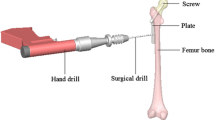Abstract
Introduction
During the drilling of the bone, the temperature could increase above 47°C and cause irreversible osteonecrosis. The spatial distribution of increase in bone temperature could only be presumed using several thermocouples around the drilling site. The aim of this study was to use infrared thermographic camera for determination of spatial distribution of increase in bone temperature during drilling.
Materials and methods
One combination of drill parameters was used (drill diameter 4.5 mm; drill speed 1,820 rpm; feed-rate 84 mm/min; drill point angle 100°) without external irrigation on room temperature of 26°C. The increase in bone temperature during drilling was analyzed with infrared thermographic camera in two perpendicular planes. Thermographic pictures were taken before drilling, during drilling with measurement of maximal temperature values and after extraction of the drill from the bone.
Results
The thermographic picture shows that the increase in bone temperature has irregular shape with maximal increase along cortical bone, which is the most compact component of the bone. The width of this area with the temperature above critical level is three times broader than the width of cortical bone. From the front, the distribution of increase in bone temperature follows the form of the cortical bone (segment of a ring), which is the most compact part and causes the highest resistance to drilling and subsequent friction.
Conclusions
Thermography showed that increase in bone temperature spreads through cortical bone, which is the most compact and dense part, and generates highest frictional heat during drilling. The medullar cavity, because of its gelatinous structure, contributes only to thermal dissipation.









Similar content being viewed by others
References
Bolhofner BR, Russo PR, Carmen B (1999) Results of intertrochanteric femur fractures treated with a 135-degree sliding screw with a two-hole side plate. J Orthop Trauma 13:5–8
Lunsjo K, Ceder L, Thorngren KG et al (2001) Extramedullary fixation of 569 unstable intertrochanteric fractures: a randomized multicenter trial of the Medoff sliding plate versus three other screw-plate systems. Acta Orthop Scand 72:133–140
Wachtl SW, Gautier E, Jakob RP (2001) Low reoperation rate with the Medoff sliding plate: 1 technical failure in 63 trochanteric hip fractures. Acta Orthop Scand 72:141–145
Feith R (1975) Side effects of acrylic cement, implanted into bone. Acta Orthop Scand 161(Suppl):3–136
Huiskes R (1980) Some fundamental aspects of human joint replacement. Acta Orthop Scand 185(Suppl):1–208
Eriksson RA, Albrektsson T, Magnusson B (1984) Assessment of bone viability after heat trauma. A histological, histochemical and vital microscopic study in the rabbit. Scand J Plast Reconstr Surg 18:261–268
Watanabe F, Tawada Y, Komatsu S, Hata Y (1992) Heat distribution in bone during preparation of implant sites: heat analysis by real-time thermography. Int J Oral Maxillofac Implants 7:212–219
Benington IC, Biagioni PA, Crossey PJ, Hussey DL, Sheridan S, Lamey PJ (1996) Temperature changes in bovine mandibular bone during implant site preparation: an assessment using infra-red thermography. J Dent 24:263–267
Aerssens J, Boonen S, Lowet G, Dequeker J (1998) Interspecies differences in bone composition, density, and quality: potential aplications for in vivo bone research. Endocrinology 139:663–670
Sedlin ED, Hirsch C (1966) Factors affecting the determination of the physical properties of femoral cortical bone. Acta Orthop Scand 37:29–48
Matthews LS, Hirsch C (1972) Temperature measured in human cortical bone when drilling. J Bone Joint Surg 54A:297–308
Jacob CH, Berry JT, Pope MH (1976) A study of the bone machining process-drilling. J Biomech 9:343–349
Augustin G, Davila S, Mihoci K, Udiljak T, Vedrina DS, Antabak A (2008) Thermal osteonecrosis and bone drilling parameters revisited. Arch Orthop Trauma Surg 128:71–77
Lentrodt J, Bull HG (1976) Animal experimental studies on bone regeneration following drilling of the bone. Dtsch Zahnarztl Z 31:115–124
Rhinelander FW (1974) Tibial blood supply in relation to fracture healing. Clin Orthop Relat Res 105:34–81
Post MJ, de Graaf-Bos AN, Posthuma G, de Groot PG, Sixma JJ, Borst C (1996) Interventional thermal injury of the arterial wall: unfolding of von Willebrand factor and its increased binding to collagen after 55 degrees C heating. Thromb Haemost 75:515–519
Eriksson AR, Albrektsson T (1983) Temperature threshold levels for heat-induced bone tissue injury: a vital-microscopic study in the rabbit. J Prosthet Dent 50:101–107
FLIR Systems AB, ThermaCAM PM695 Operator’s Manual, Publ. No. 1 557 454 Rev. B, November 2001
Sundén G (1967) Some aspects of longitudinal bone growth. An experimental study of the rabbit tibia. Acta Orthop Scand 103(Suppl):7
Acknowledgments
This experiment is a part of the scientific project Biomechanics of fractures and fracture healing and is supported by The Ministry of Science, Education and Sports.
Author information
Authors and Affiliations
Corresponding author
Rights and permissions
About this article
Cite this article
Augustin, G., Davila, S., Udiljak, T. et al. Determination of spatial distribution of increase in bone temperature during drilling by infrared thermography: preliminary report. Arch Orthop Trauma Surg 129, 703–709 (2009). https://doi.org/10.1007/s00402-008-0630-x
Received:
Published:
Issue Date:
DOI: https://doi.org/10.1007/s00402-008-0630-x




